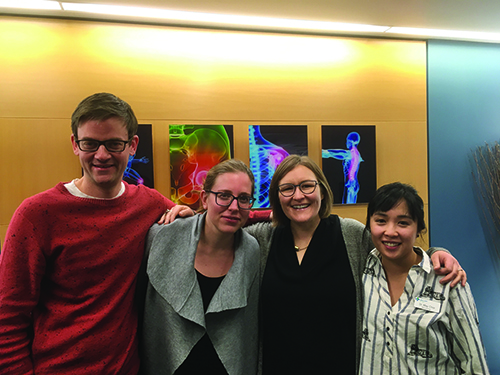Spring 2019 (Volume 29, Number 1)
Power in Numbers – Research Success as
a Cluster
By Cheryl Barnabe (CB1), MD, FRCPC, MSc;
Glen Hazlewood (GH), MD, FRCPC;
Claire Barber (CB2), MD, PhD, FRCPC; May Choi, MD,
FRCPC; and Dianne Mosher, MD, FRCPC
Download PDF
The landscape of research funding has evolved in
Canada over the last decade with changes in the
priorities and suites of funding programs available.
Clinician-scientists are faced with increasing competitive
pressures with low success rates in funding, while trying to
balance clinical and educational duties. Trainees interested
in a career in academia are expected to pursue additional
advanced fellowship training (i.e. 15-18 years or more
of training from undergraduate, through medical school,
residency, fellowship and MSc or PhD training). All these
factors have contributed to a challenging journey for those
who have chosen a clinician-scientist path. How do we as a
“research cluster” overcome these perils and still pursue our
goal of making large impacts in arthritis care while maintaining
our sanity, still having fun and keeping our families
intact? Here, we describe our made-in-Calgary solution that
illustrates key factors for success in rheumatology research.
How we got on the Clinician-scientist track:
As clinician-scientist track individuals (CB1, CB2 and GH,
and no we are not cannabinoid receptors), we were hired
after residency into clinical scholar positions, which provided
partial salary funding for a 0.3 FTE clinical position,
with the remainder of time protected for our formal graduate-degree training. Unfortunately, these clinical scholar
positions are no longer offered, but several post-residency
fellowship opportunities exist in the Department of Medicine
at the University of Calgary to support individuals to
pursue additional training.
Formal and informal mentorship networks are readily
available to young investigators, including at the O’Brien
Institute for Public Health and the McCaig Institute for
Bone and Joint Health at the University of Calgary. Additionally,
all current investigators are members of Arthritis
Research Canada (www.arthritisresearch.ca). These mentorship
networks provide project collaboration opportunities,
grant review, career advice and support with a view to establishing
collaborations within our Division, university
and nationally/internationally for early career research
success. This was in the setting of extremely supportive colleagues,
who recognized the value of clinician-scientists in
leading discovery and initiatives to improve arthritis care,
even in the face of local human resource limitations in
rheumatology at the time.
Research interest in the Division starts early as trainees
are highly encouraged to participate in research. There are
dedicated opportunities, time, and funding to support and
recognize trainee research activities from the Division and
the university.
On the Clinician-scientist track:
Under our salary model, we have real protected research
time, including recognition of our roles in the operational
committees of the CRA, and other national and international
endeavours such as the American College of
Rheumatology (ACR) committees, the Outcome Measures
in RheumAtology Clinical Trials (OMERACT) group and
the Grading of Recommendations Assessment, Development,
and Evaluation (GRADE) group. Our Division chief
and colleagues remain constant supporters of our work,
and Advanced Clinician Practitioner in Arthritis Care
(ACPAC)-trained professionals have been engaged in our
clinics to optimize patient care. New recruitment to the
Division has rounded out clinical service and education
portfolio roles to minimize the pressures of filling all the
typical academic roles.
We complement each other’s research programs and
skills, and assist one another with reviewing grant applications,
papers, and posters. We collaborate in the activities
the others are leading and recruit patients for each other’s
studies. We can apply each other’s methods and knowledge
in our own areas of research to create advancement in quality
of care, equity of care and patient-oriented methods.
We truly enjoy working together. We are sounding
boards for each other. We are great friends, are flexible
in helping each other out whether it be in clinic, on call,
or even when there is a security alarm call at each other’s
homes. We keep each other balanced, positive and moving
forward.

From left to right: Dr. Glen Hazlewood, Dr. Claire Barber, Dr. Cheryl Barnabe,
and Dr. May Choi.
Cheryl Barnabe, MD, PhD, FRCPC, MSc
Associate Professor,
University of Calgary
Calgary, Alberta
Glen Hazlewood, MD, FRCPC
Assistant Professor,
Departments of Medicine and Community Health Sciences,
Cumming School of Medicine,
University of Calgary,
Calgary, Alberta
Claire Barber, MD, PhD, FRCPC
Assistant Professor,
Rheumatologist,
University of Calgary,
Calgary, Alberta
May Choi, MD, FRCPC
Rheumatology Fellow,
Cumming School of Medicine
University of Calgary and Alberta Health Services
Calgary, Alberta
Dianne Mosher, MD, FRCPC
Professor of Medicine,
Division Head,
Rheumatology
University of Calgary,
Calgary, Alberta
|




